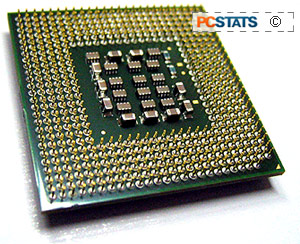The
Persistence of Vision Ray Tracer (POV-Ray) is an all round excellent package,
but there are two things that particularly make it stand out above the rest of
the crowd. Firstly, it's free, and secondly, the source is distributed so you
can compile it on virtually any platform.
HigherPixel Per Second (PPS) output equates to better
performance.
| POVray 3.5 |
| Processor |
PPS |
Ranking |
| Athlon64 3200+ |
55.62 |
   |
| Athlon64 3400+ |
61.17 |
   |
| Athlon64 FX-51 |
62.37 |
   |
| Pentium4 3.2GHz Extreme Edition |
85.61 |
   |
| Pentium4 3.2GHz Northwood |
85.57 |
   |
| Pentium4 3.2GHz Prescott |
74.8 |
   |
Persistence of Vision Raytracer is a free tool available on
the Windows, Linux, and OS X platforms for creating 3D graphics. The application
includes a built-in benchmark, which runs in its default mode without output.
The score at the end is measured in pixels per second, with a higher number
obviously being better. This time around, the Pentium 4 processors rule the
scene, with the Northwood scoring only slightly below the pricey Extreme
Edition. Unfortunately, Prescott trails again, though it still out paces any of
the three AMD Athlon 64 processors.
Conclusions on Prescott
There's
an old adage that reads "A day late and a dollar short." Without delving into
interpretation, Intel's Prescott core is much more than a day late, and in its
current incarnation, it certainly seems like a dollar short. So, dispensing with
the usual pleasantries that'd precede a formal conclusion, now is not the time to buy a processor based on Intel's new
Prescott core. At $278USD, the 3.2GHz model might be an attractive proposition,
but consider that the processor is, in most cases, a hair slower than Northwood,
particularly picky in the motherboard compatibility department, and reportedly
on the verge of being displaced by Intel's new LGA-775 formfactor, a new
interface forecasted to appear in the second quarter of 2004.
 With that said, Intel made a
lot of changes to the Prescott core that will play a more prolific role in the
next year or two. SSE3, for example, promises to augment the processor's
performance through the utilization of software optimizations.
With that said, Intel made a
lot of changes to the Prescott core that will play a more prolific role in the
next year or two. SSE3, for example, promises to augment the processor's
performance through the utilization of software optimizations.
Enhancements to Hyper-Threading should improve multi-threaded
performance. And of course, the technological improvements to Intel's 90nm
manufacturing process will enable a 4GHz variant of the Pentium 4 by the end of
2004…
…that
leads in to a subject that hasn't yet been discussed. Prescott should be a
marvelous platform for overclocking, given its newfound scalability.
Unfortunately, motherboard compatibility precluded an in-depth look at
overclocking here, but you can expect enthusiasts will want to have a go at the
less expensive Prescott processors with the hope of lofty gains.
Remember
also that Intel is unveiling several processors, not just a 3.2GHz Prescott. At
the enthusiast level, a 3.4GHz Pentium 4 Extreme Edition based on the Gallatin
core is available for $999USD. Both 3.4GHz Prescott and Northwood processors are
also emerging, priced at $417USD. And finally, Prescott will also surface at
3.0GHz ($218USD), 3.06GHz ($218USD), and 2.8GHz ($178USD). Some forecasts even
predict Prescott-based Celeron processors on the horizon.
If you're
currently in the market for a new platform, hold off if you can. It may sound
like the same old story, but the next few months will be uncharacteristically
action-packed. Intel's next-generation chipsets, now being referred to as 925X
and 915, will emerge in the second quarter of 2004 along with a 3.6GHz Pentium 4
of the Prescott variety. In addition, the new platforms will introduce PCI Express graphics and DDR2 memory support, along
with extended Serial ATA connectivity and the option for integrated wireless. As
if that weren't enough, AMD is expected to unveil its Socket 939 Athlon 64 3700+
and FX-53 in the same time frame.
Find out about this and many other reviews by
joining the Weekly PCstats.com Newsletter today!
Related Articles
Here are
a few other articles that you might enjoy as well...
1. Intel Pentium
4 3.0GHz 800MHZ FSB Processor Review
2. Intel Pentium
4 2.8 GHz Processor Review